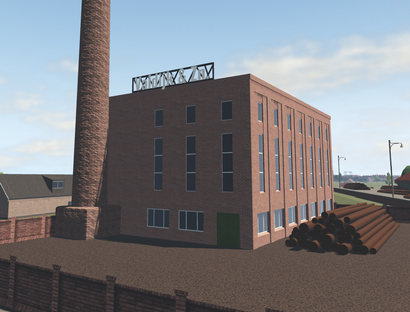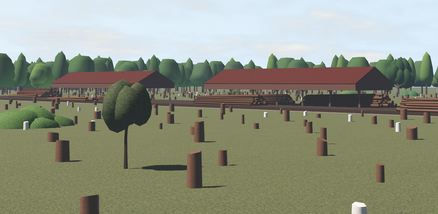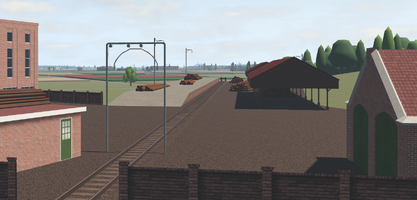Valdijk & Zn. is a family-owned lumber company founded in the mid-1890s by Geert J. Valdijk, who saw a lucrative business in selling wood for the expanding railways in the region.
The early years (1890s - 1920s)
Geert Valdijk, farmer by trade, began a company called Valdijk's Houtkap en -bewerkingsbedrijf (Valdijks wood cutting and wood working company) in 1894 in response to seeing the railways expand in and around Voorlem. He built a small shed at the forest rich hills of Wezinge and offered his services to the railways. The railways jumped at the chance to get wood for the sleepers and rolling stock locally, which Geert could deliver by using his farming equipment and experience to a limited degree.

Around 1898, he rebuilt his equipment to better suit his new needs. This allowed him to farm enough lumber to expand his services and he began making furniture on a small scale, although the railways remained his main source of income. The battle of expansion among different railway companies earned Valdijk enough money to replace the old shed with a proper brick building, which was finished in 1902.
The factory building brought a new motivation to Geert, who showed his son, Jan T. Valdijk, the factory inside and out six times in the opening week. Jan could often hear whistling between the sawing and grinding of the machines and found the cheerfulness so infectious that he joined his father in the business. Geert allowed the little Jan to just do little things like sorting wood or help bring furniture to customers, but eventually treated his son as if they were equal business partners. The Valdijk duo expanded on their furniture business in 1911, which is considered the sole reason that Valdijk's Houtkap en -bewerkingsbedrijf survived the declining railway business during and after the First World War. It was during those years Jan took over most of the work as his father, now in his early 50s, began having health problems. This ultimately resulted in Geert leaving the business entirely to Jan in 1921.
The rise of specialised companies meant that the Valdijk furniture business found fierce competition. Jan Valdijk stopped producing furniture in 1922 due to this competition and the memories of making furniture together with his father making the activity much less enjoyable. But, much like his father before him, Jan saw a business oppportunity and began to produce planks, blocks and other lumber that could easily be worked into furniture. This put the business back on the map again, however, the hills of Wezinge had too little forest left to supply the demand.
The years of trouble (1930s - 1940s)

In the early 1930s, Jan Valdijk kept the business afloat by what he calls the "possibly not entirely lawful acquisition of wood" by posing as gardeners, maintenance crew and other odd jobs that allowed him to cut considerable amounts of trees from various places around Voorlem. He would use his personal truck to transport the wood back to his company.
Valdijk's furniture wood had gotten so popular that demand for it also came from overseas. Valdijk began exporting his lumber in 1935, albeit in small amounts due to his limited transport options.
In 1937, he purchased a plot of forested land near IJssel aan Zee and reached an agreement with NS. His company connection and his wood cutting area its own siding and his wood and lumber would be transported for a reduced cost so long as Valdijk would continue to supply the railways with wood when they needed it. Valdijk took the risk despite the introduction of entirely metal rolling stock drastically reducing the railways' need for lumber and his own lack of knowledge of railway scheduling.
Luckily, Jan T. Valdijk had become a father in 1918 of a son who grew up with a fascination for the railways. Johan G. Valdijk, now 19 years old, helped out his father by designing Valdijk's simple track lay-out as it is today. As a thank you, Jan renamed the company to Valdijk & Zn. (Valdijk & son) and allowed his son into the business as his father had done with him. The two created a special set of commemorative and celebratory furniture that is highly sought after by collectors, as a few sets were made incomplete or entirely destroyed in the war that followed a few years later.

WWII (1940-1945)
After the Dutch capulation, Valdijk was forced to provide lumber to the ruling forces. To spite them, the father & son duo used their combined knowledge to provide low quality wood at inconvenient times whenever they could, whilst supplying the local resistance with hiding places for their supplies, scattered across their company ground. Jan T. Valdijk often says he wishes he could have done more, but the fear something could happen to his boy held him back.
The ruling forces paid Valdijk & Zn. very little for the wood they supplied, irrelevant of the quality provided. A majority of their employees were fired to avoid total bankruptcy, something the company was crawling closer and closer to.
The redemption (1946 - modern day)
When the war was over, Valdijk & Zn. played a crucial role in rebuilding the country by supplying high quality building materials for little to no cost. This brought them to the very verge of bankruptcy, but made the company well-known around the region for its high quality lumber. Jan Valdijk recounts sitting at his desk with the bankruptcy form laying in front of him, unscrewing his pen to fill it in, only for his sadness to be interrupted by a loud smack as Johan dropped a pile of orders on the desk.
Throughout the remainder of the 1940s, the company grew back to its former glory. The old deal of the railways held up and allowed the Valdijks to increase their export of processed lumber, which was in demand as more places were being rebuilt. The two also developed a schedule for the cutting and planting of trees, ensuring that the company will have enough trees left over when Johan eventually takes his father's place as the head of the company. This may take some time as Jan, now well into his 50s, continues to work with a smile on his face and his son at his side.
